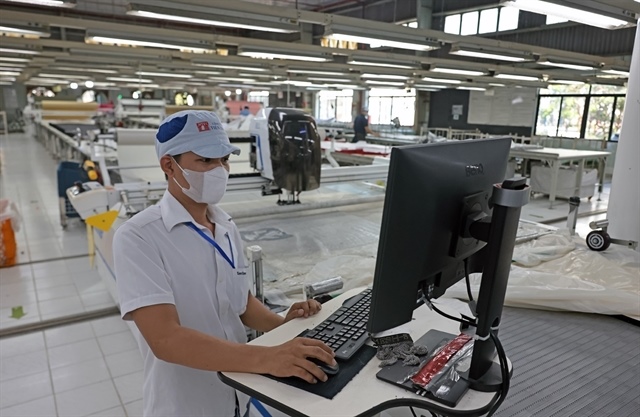Private sector is driving force for advances across economy
Private sector is driving force for advances across economy
Thanks to open-door policies crafted from the 1980s and beyond, rapid development of legal infrastructure, recognition of the value of foreign direct investment, and the importance of a strong private sector, Vietnam has made tremendous progress to a point where, this year, Vietnam’s average per capita income should reach $5,000, total foreign trade could be well over $850 billion, and there is a poverty rate below 5 per cent.

Kenneth Atkinson, founder and senior board advisor Grant Thornton Vietnam |
In most countries around the world, the private sector is the key driver and contributor to economic growth. Globally, the private sector contributes 70 per cent of GDP and 85 per cent of global employment, whilst small- and medium-sized enterprises (SMEs) represent 90 per cent of businesses worldwide and half of global employment. Registered SMEs in emerging markets are said to contribute 40 per cent of GDP.
In Vietnam, the main focus historically was on the state sector, which led to the inefficient use of resources. Formally, we did not have a private sector until 25 years ago. Today, it is estimated that the private sector contributes around half of GDP and almost one-third of the state budget, creating over 40 million jobs accounting for more than 80 per cent of the total workforce.
So, Vietnam’s preparation in positioning private sector development as a crucial driver of Vietnam’s socialist-oriented market economy will help to foster a strong private sector, and which will facilitate a more efficient use of economic resources.
Vietnam should ensure clear strategic objectives for the private sector’s role in achieving Vietnam’s development goals. This includes targets for GDP growth, employment, technological advancement, and sustainable development.
Several actions are required. The first is to establish a policy framework that encourages private sector investment and innovation is crucial. This can be achieved through tax incentives, subsidies, and grants for research and development. Encouraging public-private partnerships is another vital element. These can help develop infrastructure, healthcare, education, and other critical sectors, with stakeholders gaining access to international best practices and the public sector with facilities and the means to upgrade them.
The second aspect is to simplify business regulations to reduce compliance costs and administrative burdens. This will streamline processes for obtaining permits, licences, and approvals will foster a more business-friendly environment. Too much time is currently wasted on businesses complying with constant requests because of often overlapping and unclear regulations.
Improving access to finance for SMEs is also essential to enhance credit facilities, reduce interest rates, and provide guarantees for loans to help them thrive. Many do not have at their disposal fixed assets which banks require to support loans, so the current and traditional basis for lending needs to change, requiring trained credit analysts.
Apart from this, encouraging the adoption of new technologies and innovation by providing support for startups and tech-driven enterprises is also important. This includes funding for research and development and creating innovation hubs. Investing in education and training programmes to build a skilled workforce that meets the needs of the private sector is crucial. This includes vocational training, apprenticeships, and continuous professional development for many jobs.
Other factors involve facilitating access to domestic and international markets by reducing trade barriers, improving logistics, and supporting export-oriented businesses. This will help ensure that private sector growth is sustainable and inclusive by encouraging environmentally friendly practices and supporting businesses owned by women, minorities, and other underrepresented groups.
To reduce some of the bottlenecks currently facing businesses in the private sector and to encourage faster growth, Vietnam needs to address regulatory barriers. The government needs to address the complexity and inconsistency of business regulations that hinder market entry and innovation. Simplifying such things as licensing procedures, work permits, temporary residence cards, and work visas can help ensure consistent public service delivery.
Also, the government has to expand its infrastructure spending to support business operations, including in transport, energy, and digital infrastructure.
The high cost associated with doing business has to be addressed. This includes inspections, permitting delays, logistical bottlenecks, and lack of transparency in matters related to tax and customs inspections, with no right of appeal other than through the courts or arbitration.
One thing that the private sector does not like is legal and policy uncertainty. The government needs to ensure a stable and predictable business environment with complete transparency and consistent application of laws, rules, and regulations.
Having workplace-ready students at all levels is currently a challenge for businesses across the board. Education and training programmes need to be aligned with the needs of employers. We must have more programmes of continuous learning and upskilling, not just within the professions, to meet the demands of a dynamic and fast-changing economy.
By addressing these issues and removing the bottlenecks, the private sector will be able to play a more significant and efficient role in driving economic development, in line with the country’s development goals.
The current plan for institutional and provincial reform should, when implemented in a robust and fair fashion, go a long way to addressing many of the bottlenecks, but positions must be competency-based. So, we are well-placed to move to a strong private sector being the main driver for future growth and whilst this may take a period of time with the right degree of government support, there is everything to play for with the aim of Vietnam developing into a high-income country by 2045.
- 09:11 17/04/2025



























